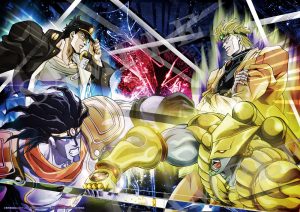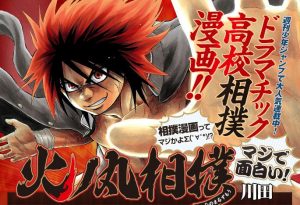
Considering the long running nature and various adaptations to JoJo, we have finally entered part 4 as we explore one of its most unique features that can be expressed through audio, its catchphrase and battlecries!
Catch Phrases/Battle Cries
One of the most notable battlecries from JoJo are Dio’s “MUDA MUDA MUDA” and/or Jotaro’s “ORA ORA ORA” whenever they throw a barrage punches. This goes back to how JoJo was initially copying/spoofing Hokuto no Ken, one of the biggest hits of the 80s. Whenever Kenshiro, the hero to that series, would throw a barrage of punches, he would scream ATATATATA like Bruce Lee. When it comes to Jotaro screaming “ORA ORA ORA,” it’s a typical Japanese way of getting yourself pumped up for a fight. This battle cry has also been popularized by Akira from Virtua Fighter, Dan from Street Fighter Alpha, and Joe Higashi from Fatal Fury.
As for Dio’s battlecries, “MUDA MUDA MUDA,” or simply “Muda da,” it just means something along the lines of “resistance is futile,” or whatever his opponent is doing is “useless.” As the series progresses into Golden Wind, Giorno, Dio’s son, would also adopt this battlecry as his own. In addition to “MUDA MUDA MUDA” and “ORA ORA ORA,” both rivals have other notable catchphrases. For Dio, he often likes to scream “WRYYYYYYYY (or however you spell it), and this was popularized through the Capcom fighter, in which it is enhanced by computer modulation. Thanks to Takehito Koyasu’s over the top performance as Dio, he has also popularized “KONO DIO DA,” or “IT WAS ME, DIO” after he kisses Elena.
For Jotaro, he often says “yare yare daze,” (and his own daughter would adopt a feminine variation to it, “yare yare dawa”) or officially referred to as “good grief” in English. This is something you can use in everyday Japanese whenever you feel dumbfounded about something. Though “good grief” is one way of putting it, you can also simply interpret it as a simple “oh, well,” “give me a break,” or “come on.”
Numerous Voice Actors
As most of you (probably) know, Takehito Koyasu isn’t the only one who has played Dio. Due to the numerous anime incarnations and video games based on JoJo, all characters have had numerous seiyuu. In addition to Takehito Koyasu, Norio Wakamoto played him in a drama CD, Nobuo Tanaka played him in the OVAs, Hikaru Midorikawa played him in the panned Phantom Blood movie, and the WRYYYYY battle cry was coined by his game seiyuu, Isshin Chiba. For Jotaro, though Daisuke Ono plays him in the present anime, his previous seiyuu include Jurota Kosugi from the OVA and Kiyoyuki Yanada in the Capcom fighter.
However, some seiyuu have crossed over between adaptations of JoJo. For example, Takehiro Sakurai, the voice of Rohan from Diamond is Unbreakable, previously voiced Bucciarati in the PS2 game of Golden Wind. Hiroaki Miura, who voiced Fugo in that respective game would also voice Joshu Higashitaka (a character from JoJolion) in All Star Battle and Eyes of Heaven. Furthermore, Romi Park who voiced Giorno in the Golden Wind game, would also voice Koichi for the PS3 and PS4 games. For the PS3 and PS4 games, Giorno’s seiyuu would be Daisuke Namikawa and for the anime, Kensho Ono would assume the role. For Koichi in the anime to Diamond is Unbreakable, Yuuki Kaji was casted for the role.
Final Thoughts
JoJo, as a whole, with its structure, not only has gone through an evolution with its story but to its style as well. The series was initially conceived to be more of a macho story akin to Hokuto no Ken. When you start from the beginning, it emphasizes more on buff bodies, violence and hand to hand combat. The Hamon, which was used to combat vampires initially phases out by part 3 in favor for Stands, astral warriors only a few can possess. Thanks to the introduction of Stands, it helped JoJo solidify its identity.
In addition to the nature of the action changing between parts 2 and 3, so has the art style. For the first three story arcs, JoJo appropriately emphasizes masculinity but from part 4, Araki emphasizes on skinnier characters since they tend to be barely teenagers. The series has been known for conveying masculinity in unconventional manners to most cultures and this is certainly seen in the poses which take influence from European fashion magazines. The poses do a great job of putting the “Bizarre,” or “Kimyou” in its title. It’s Araki’s way of certainly trying to use body language at its most extreme. When you look at the poses on the manga covers complimented by its vibrant colors, it makes you think Araki had to be on psychedelics to draw this stuff and the anime in turn does a great job of using such color/presentation schemes when necessary. As to why JoJo has such scenes, we can only assume that due to some of its progressive rock influences, a psychedelic effect had to be necessary to suck you into its atmosphere.
A lot of JoJo’s influences don’t come from just music, but from classic and modern European culture as well. This is notably seen in the clothing designs from parts 4 and 5. JoJo is one of those rare series where you can get just a bit of everything and when you view each part in context to when the original manga debuted, you can get an idea as to how perceptions of masculinity have evolved in certain cultures. However, no matter what part you expose yourself to, you’re still promised exciting action and references to music and movies, and some odd poses and easy to pick up Japanese lines.
Recommended Post




